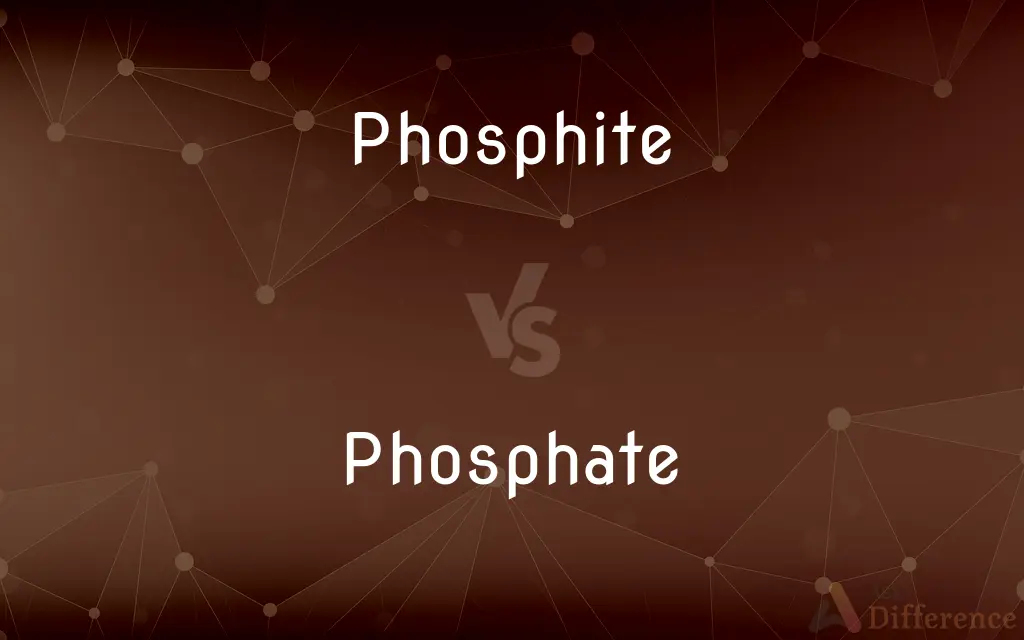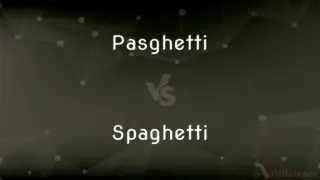Phosphite vs. Phosphate — What's the Difference?
By Tayyaba Rehman & Urooj Arif — Updated on April 7, 2024
Phosphite ions are reduced forms of phosphate ions, with phosphite containing three oxygen atoms and phosphate containing four.

Difference Between Phosphite and Phosphate
Table of Contents
ADVERTISEMENT
Key Differences
Phosphite is a polyatomic ion with the formula HPO₃²⁻, characterized by a trivalent phosphorus atom bonded to three oxygen atoms. It acts as an antioxidant in some organisms and is used in certain fertilizers. Whereas phosphate, with the formula PO₄³⁻, is a tetra-valent phosphorus atom bonded to four oxygen atoms, playing a crucial role in biological systems, including DNA structure and energy transfer.
Phosphites are often used in agriculture as fungicides and biostimulants due to their ability to enhance plant defense mechanisms against pathogens. On the other hand, phosphates are widely used as fertilizers to promote plant growth by providing essential nutrients, particularly phosphorus.
In terms of environmental impact, phosphite ions are less stable and can be more readily assimilated by plants and microorganisms, potentially reducing the risk of environmental pollution. Whereas phosphate ions are more stable and persistent in the environment, which can lead to eutrophication of water bodies if not managed properly.
Phosphites, being more soluble and having a different oxidation state than phosphates, are absorbed differently by plants and may not directly contribute to the phosphorus nutrition of the plant. In contrast, phosphates are directly utilized by plants for growth and development, being a primary source of phosphorus.
The regulatory status of phosphites and phosphates also differs, with phosphites being regulated in some regions as pesticides due to their fungicidal properties, while phosphates are regulated primarily as fertilizers, given their role in plant nutrition.
ADVERTISEMENT
Comparison Chart
Oxidation State
+3
+5
Oxygen Atoms
3
4
Role in Agriculture
Fungicide and biostimulant
Fertilizer
Environmental Impact
Less stable, reduced pollution risk
More stable, potential for eutrophication
Regulatory Status
Often regulated as a pesticide
Regulated as a fertilizer
Compare with Definitions
Phosphite
Used as a biostimulant in agriculture.
Phosphite applications can enhance a plant's natural defense mechanisms.
Phosphate
Can cause environmental issues if overused.
Excess phosphate runoff leads to the eutrophication of water bodies.
Phosphite
A reduced form of phosphate used in fungicides.
Phosphite treatments have been effective against downy mildew.
Phosphate
An ion crucial for biological processes.
Phosphate groups are key components of ATP, the energy currency of the cell.
Phosphite
A salt or ester of phosphorous acid.
Potassium phosphite is used to protect plants from fungal diseases.
Phosphate
Present in DNA and RNA structure.
The phosphate backbone is essential for the stability of DNA.
Phosphite
An ion with three oxygen atoms bonded to phosphorus.
The phosphite ion acts differently in the soil compared to phosphate.
Phosphate
A major nutrient for plant growth.
Phosphate fertilizers are widely used to improve crop yields.
Phosphite
Present in some ecosystems as an antioxidant.
Phosphite plays a role in the stress response of some marine organisms.
Phosphate
A salt or ester of phosphoric acid.
Diammonium phosphate is a common fertilizer in agriculture.
Phosphite
Old-fashioned term for phosphonate
Phosphate
In chemistry, a phosphate is an anion, salt, functional group or ester derived from a phosphoric acid. It most commonly means orthophosphate, a derivative of orthophosphoric acid H3PO4.
Phosphite
A salt, ester, or anion of phosphorous acid.
Phosphate
A salt or ester of phosphoric acid, containing PO₄³⁻ or a related anion or a group such as —OPO(OH)₂.
Phosphite
(chemistry) any salt or ester of phosphorous acid
Phosphate
An effervescent soft drink containing phosphoric acid, soda water, and flavouring.
Phosphite
(chemistry) the anion PO33-, or the trivalent radical PO3
Phosphate
A salt, ester, or anion of phosphoric acid, derived by removal or replacement of one, two, or especially all three of the hydrogens of phosphoric acid.
Phosphite
A salt of phosphorous acid.
Phosphate
A fertilizer containing phosphorus compounds.
Phosphate
A soda fountain drink made by blending carbonated water with flavored syrup.
Phosphate
(chemistry) Any salt or ester of phosphoric acid.
Phosphate
(agriculture) Any fertiliser containing phosphate compounds.
Phosphate
Guano (containing high levels of phosphates and harvested for the fertiliser industry).
Phosphate
A carbonated soft drink containing phosphoric acid, often flavored with a fruit-based syrup.
Phosphate
To treat or coat with a phosphate or with phosphoric acid
Phosphate
A salt of phosphoric acid.
Phosphate
A salt of phosphoric acid
Phosphate
Carbonated drink with fruit syrup and a little phosphoric acid
Common Curiosities
How do plants absorb phosphite and phosphate?
Plants absorb phosphite and phosphate differently due to their distinct chemical structures and oxidation states.
What is the main difference between phosphite and phosphate?
The main difference lies in their oxidation states and the number of oxygen atoms; phosphite has three oxygen atoms and a +3 oxidation state, while phosphate has four oxygen atoms and a +5 oxidation state.
Can phosphite be used as a source of phosphorus for plants?
While phosphite can be absorbed by plants, it is not a direct source of phosphorus in the same way as phosphate.
Is phosphate essential for DNA and RNA?
Yes, phosphate groups are essential components of the DNA and RNA structure.
Why is phosphite considered a biostimulant?
Phosphite enhances plant defense mechanisms against pathogens, acting as a biostimulant.
How do phosphite and phosphate affect water quality differently?
Phosphite is less stable and less likely to contribute to eutrophication than phosphate, which is more stable and can adversely affect water quality.
Can phosphite applications harm beneficial soil microbes?
Phosphite is generally considered less harmful to beneficial soil microbes compared to some chemical treatments.
Are phosphite and phosphate interchangeable in agricultural use?
No, they serve different purposes; phosphite is mainly used as a fungicide and biostimulant, whereas phosphate is used as a fertilizer.
Why is phosphate more likely to cause environmental problems than phosphite?
Phosphate is more stable and can lead to eutrophication of water bodies due to its persistence in the environment.
What role does phosphate play in the energy transfer within cells?
Phosphate is a key component of ATP, which is crucial for energy transfer within cells.
What are the regulatory differences between phosphite and phosphate?
Phosphite is often regulated as a pesticide, while phosphate is regulated as a fertilizer.
Can the use of phosphite reduce the risk of plant diseases?
Yes, phosphite can reduce the risk of certain plant diseases by acting as a fungicide and enhancing plant immunity.
How does the solubility of phosphite and phosphate compare?
Phosphite is typically more soluble than phosphate, affecting how they are absorbed and used by plants.
What are the consequences of overusing phosphate fertilizers?
Overusing phosphate fertilizers can lead to environmental issues, such as water pollution and eutrophication.
Share Your Discovery

Previous Comparison
Virile vs. Masculine
Next Comparison
Pasghetti vs. SpaghettiAuthor Spotlight
Written by
Tayyaba RehmanTayyaba Rehman is a distinguished writer, currently serving as a primary contributor to askdifference.com. As a researcher in semantics and etymology, Tayyaba's passion for the complexity of languages and their distinctions has found a perfect home on the platform. Tayyaba delves into the intricacies of language, distinguishing between commonly confused words and phrases, thereby providing clarity for readers worldwide.
Co-written by
Urooj ArifUrooj is a skilled content writer at Ask Difference, known for her exceptional ability to simplify complex topics into engaging and informative content. With a passion for research and a flair for clear, concise writing, she consistently delivers articles that resonate with our diverse audience.














































